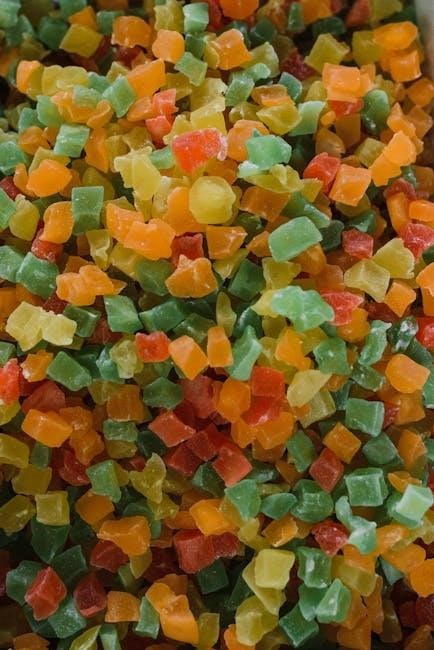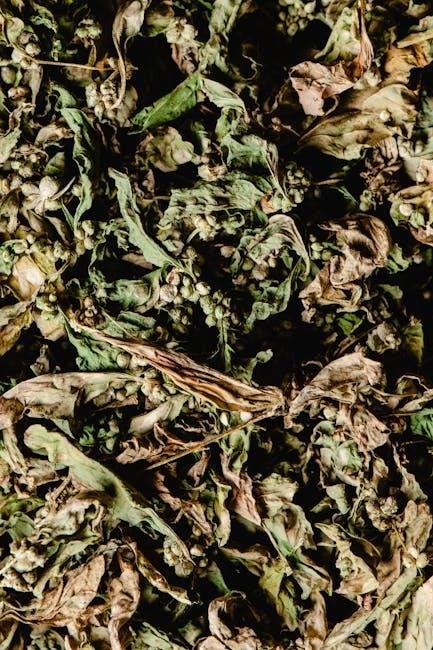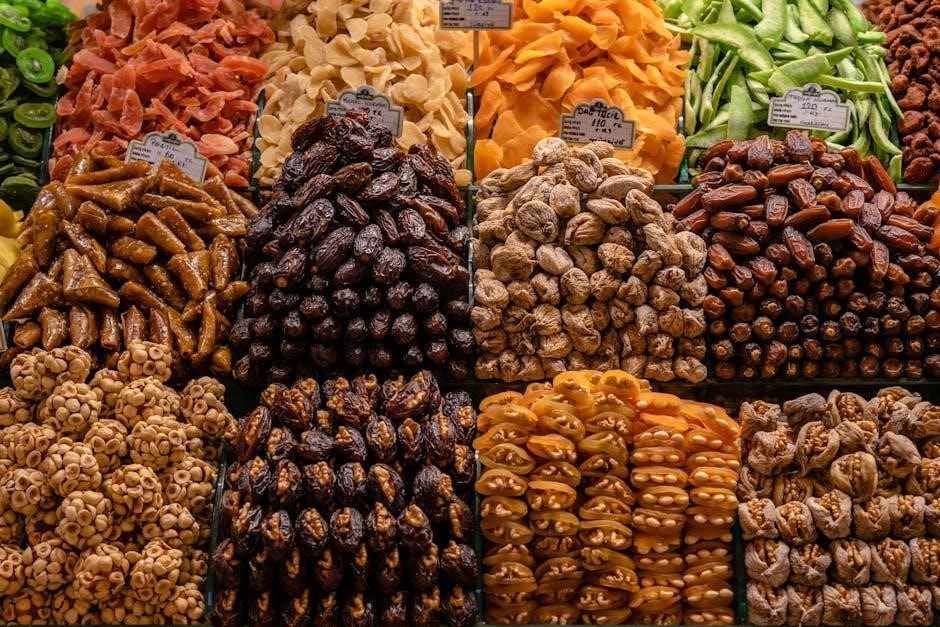A food dehydrator is a kitchen appliance that preserves food by removing moisture using low heat and airflow, helping retain nutrients and extend shelf life․ Ideal for making healthy snacks, storing meals, and maintaining food freshness, it’s a versatile tool for home preservation and culinary creativity․
1․1 What is a Food Dehydrator?
A food dehydrator is a kitchen appliance designed to preserve food by removing moisture through low heat and airflow, preventing spoilage and retaining nutrients․ It works by circulating heated air, typically between 95°F and 160°F, to extract water from foods like fruits, vegetables, meats, and herbs․ This process inhibits microbial growth, allowing food to be stored for extended periods․ Unlike canning or freezing, dehydrated foods are lightweight, portable, and require no refrigeration․ A food dehydrator is an ideal tool for creating healthy snacks, backpacking meals, and preserving seasonal produce, offering a cost-effective and nutritious way to enjoy food year-round․
1․2 How Does a Food Dehydrator Work?
A food dehydrator operates by circulating heated air at controlled temperatures to remove moisture from food․ It uses a combination of heat, typically between 95°F and 160°F, and airflow to evaporate water content; The appliance consists of a heating element, fan, and trays where food is placed․ As the food dries, the moisture is carried away by the circulating air, preserving the food and preventing spoilage․ This process is quieter and more efficient than traditional methods, making it ideal for preserving a variety of foods while retaining their nutrients and flavors․ The even heat distribution ensures consistent drying results․
1․3 Benefits of Using a Food Dehydrator
Using a food dehydrator offers numerous benefits, including preservation of nutrients, long-term food storage, and reduced waste․ It allows for healthy, preservative-free snacks like jerky and fruit leather․ Dehydrated foods are lightweight, making them ideal for backpacking and travel․ The process retains food’s natural flavors and nutrients while removing moisture to prevent spoilage․ It’s also cost-effective, as homemade dried foods are often cheaper than store-bought options․ Additionally, dehydrating enables year-round enjoyment of seasonal produce and supports sustainable eating habits by utilizing food that might otherwise go unused․
Choosing the Right Food Dehydrator
Selecting the right food dehydrator involves considering key features like adjustable temperature, timer, capacity, and materials․ Look for models with stackable trays for flexibility and expandability․ Brands like Excalibur and Cosori offer high-quality options with advanced settings, ensuring efficient dehydration for various foods․ Choose a dehydrator that fits your needs, whether for small batches or large-scale preservation, and ensure it aligns with your budget and kitchen space․
2․1 Key Features to Look For
When selecting a food dehydrator, key features to consider include adjustable temperature control, allowing precise settings for different foods, and a built-in timer for consistent results․ Capacity is crucial, with larger models offering more space for bulk dehydration․ Stackable trays enhance versatility, enabling multiple food types to be dried simultaneously․ Durable materials, such as stainless steel or BPA-free plastic, ensure longevity․ Horizontal airflow in front-loading models prevents flavor mixing, while vertical airflow in stackable designs may cause cross-flavors․ Additional features like quiet operation and easy cleaning add convenience, making the dehydrator a practical and efficient kitchen tool for various preservation needs․
2․2 Adjustable Temperature and Timer Settings
Adjustable temperature and timer settings are essential for precise dehydration․ Set temperatures between 35°C to 71°C (95°F to 160°F) to suit different foods, ensuring optimal drying without overcooking․ Timers allow unattended operation, preventing over-drying by automatically shutting off once the process is complete․ These features enhance efficiency and ensure consistent results, whether preserving delicate herbs or tougher meats․ Proper temperature control inhibits bacterial growth and retains food quality, making these settings vital for successful dehydration across various food types and desired outcomes, ensuring safety and flavor preservation in every batch․
2․3 Capacity and Stackability
Capacity and stackability are crucial for efficient dehydration, especially when handling large batches․ Dehydrators with ample space allow for drying multiple food types simultaneously, saving time and effort․ Stackable models offer expandability, enabling users to add trays as needed for increased capacity․ This feature is ideal for bulk preservation, catering to households or heavy users․ However, larger capacities may come with higher costs․ Assessing personal needs will help choose the right size, ensuring the appliance meets dehydration demands without unnecessary expense, while stackability provides flexibility for future growth in food preservation activities and batch processing efficiency․
2․4 Materials and Construction
The materials and construction of a food dehydrator significantly impact its performance and durability․ High-quality dehydrators often feature double-wall construction using metal or high-grade plastic for better heat retention and safety․ Stainless steel trays are preferred for their durability and ease of cleaning, while models with BPA-free plastic ensure food safety․ A sturdy, well-insulated design prevents heat loss and ensures consistent drying․ Additionally, dehydrators with horizontal airflow, often front-loading, reduce flavor transfer between trays and prevent liquids from dripping onto the heating element, making cleanup easier and enhancing overall efficiency for long-term use․
2․5 Recommended Brands (e․g․, Excalibur, Cosori)
Excalibur and Cosori are top-tier brands in food dehydrators, offering durability and advanced features․ Excalibur, a long-standing leader since 1973, is known for its robust construction and reliability․ Cosori, a newer brand, excels with quiet operation, stainless steel designs, and user-friendly interfaces․ Both brands provide models with adjustable temperature and timer settings, essential for precise control․ They cater to various needs, from home use to bulk dehydration, ensuring high-quality results․ These brands are trusted for their commitment to innovation and customer satisfaction, making them excellent choices for both beginners and experienced users․

Preparing Food for Dehydration
Preparing food involves selecting fresh ingredients, washing, and slicing uniformly for consistent drying․ Pretreatment methods like ascorbic acid can preserve color and flavor; Always follow guidelines for best results․
3․1 Selecting the Right Foods for Dehydration
Selecting the right foods for dehydration is crucial for success․ Fruits, vegetables, herbs, and lean meats are ideal due to their low fat and high nutrient content․ Avoid high-fat foods like dairy and olives, as they can spoil during dehydration․ Herbs and spices are excellent for drying, preserving their flavors for year-round use․ Ensure all foods are fresh and free from blemishes to achieve optimal results and maintain safety․ Proper selection ensures effective dehydration and long-term preservation․
3․2 Washing and Cleaning Food
Washing and cleaning food is essential before dehydration to remove dirt, bacteria, and pesticides․ Rinse fruits and vegetables under cool running water, gently scrubbing firm-skinned produce like apples and potatoes․ For delicate foods like herbs, a quick rinse or misting with water suffices․ Remove any damaged or bruised areas to prevent spoilage․ Pat food dry with a clean towel or paper towels to reduce moisture, ensuring even dehydration․ Cleanliness prevents contamination and ensures the quality of your final product․ Proper preparation is key to safe and successful food dehydration․
3․3 Slicing and Uniform Cutting
Uniform slicing ensures consistent drying and prevents undercooked or overcooked areas․ Use sharp knives or mandolines to cut food into even thickness, typically between 1/8 to 1/4 inches․ Slice fruits like apples and bananas thinly for crispy snacks, while vegetables such as carrots and zucchini can be cut into sticks or rounds․ Meats should be sliced against the grain for tender jerky․ Uniformity guarantees faster dehydration and better texture, enhancing the overall quality of your dried products․ Proper cutting techniques are crucial for achieving optimal results in food dehydration․
3․4 Pretreatment Methods (e․g․, Ascorbic Acid)
Pretreatment methods enhance color retention, texture, and flavor in dehydrated foods․ Ascorbic acid, commonly used, prevents browning in fruits like apples and bananas․ Dissolve 1 tablespoon of ascorbic acid in a quart of water, soak sliced fruits for 10 minutes, then pat dry․ Blanching vegetables briefly in steam or boiling water preserves color and nutrients․ Soaking herbs in cold water before drying can reduce loss of volatile oils․ Proper pretreatment ensures vibrant colors, better taste, and longer freshness in your dehydrated creations․
Operating the Food Dehydrator
Place the dehydrator on a level surface, arrange food evenly on trays without overlapping, set the correct temperature, and monitor drying progress for best results․
4․1 Setting Up the Dehydrator
Place the dehydrator on a heatproof, stable surface, away from curtains or flammable materials․ Ensure the area is well-ventilated for proper airflow․ Plug the device into a nearby electrical outlet and confirm the surface is level․ Arrange the trays without overlapping food, following the manufacturer’s guidelines․ Set the timer and temperature according to the food type being dehydrated, ensuring optimal drying conditions․ Always refer to the user manual for specific setup instructions to guarantee safety and efficiency during operation․
4․2 Placing Food on Dehydrator Trays
Arrange food evenly on dehydrator trays, ensuring uniform slicing for consistent drying․ Avoid overlapping food to allow proper airflow․ Place slices in a single layer, leaving space between pieces․ Follow the manufacturer’s guidelines for tray capacity and food type․ Delicate foods like herbs may require a liner or parchment paper to prevent sticking․ Always refer to the food dehydration guide for specific placement recommendations to achieve optimal results and prevent uneven drying․
4․3 Temperature and Time Guidelines
Set temperatures between 135°F and 160°F for most foods, adjusting according to the type․ Fruits typically require 135°F–150°F, while vegetables need slightly higher settings․ Herbs dry best at lower temperatures, around 95°F–115°F․ Timing varies from 6–12 hours for fruits and vegetables to 3–6 hours for herbs․ Always check the dehydrator’s guidelines and monitor the process to ensure food reaches 95% dryness for shelf stability․ Proper temperature and time settings prevent under-drying and spoilage, ensuring safe and effective preservation․
4․4 Monitoring the Dehydration Process
Regularly check the dehydration progress to ensure optimal results․ Start by monitoring after the halfway point of the recommended time․ Rotate trays for even drying and avoid overcrowding․ Check for dryness by breaking or bending the food—if it snaps cleanly for vegetables or feels leathery for fruits, it’s done․ Over-drying can lead to brittleness or loss of flavor․ Ensure foods reach 95% dryness for shelf stability․ Proper monitoring prevents under-drying, which can cause spoilage, and ensures a safe, high-quality final product for storage or consumption․

Dehydrating Specific Foods
Dehydrating specific foods like fruits, vegetables, meats, and herbs offers tailored techniques for optimal results․ Explore detailed guides for each food type to achieve perfect texture and flavor․
5․1 Fruits (e․g․, Apples, Bananas, Berries)
Fruits like apples, bananas, and berries are ideal for dehydration․ Slice apples thinly and dehydrate at 135°F (57°C) for 6-8 hours until crispy․ Bananas can be dried into chips or leathery strips․ Berries, such as strawberries or blueberries, should be halved or kept whole and dried at 135°F (57°C) for 6-10 hours․ Pretreatment with ascorbic acid prevents browning․ Uniform slicing ensures even drying․ These dehydrated fruits make perfect snacks or additions to trail mixes and granolas․
5․2 Vegetables (e;g․, Carrots, Potatoes, Tomatoes)
Vegetables like carrots, potatoes, and tomatoes dehydrate beautifully, retaining their nutrients and flavors․ Slice carrots thinly and dehydrate at 135°F (57°C) for 6-8 hours until crispy․ Potatoes can be dried into chips or slices, requiring a slightly higher temperature of 145°F (63°C) for 4-6 hours․ Tomatoes can be dried whole, halved, or as powder․ Blanching vegetables before dehydration helps preserve color and texture․ Ensure even drying by avoiding overcrowding trays․ Store dried vegetables in airtight containers for later use in soups, stews, or as snacks․
5․3 Meats and Jerky
Dehydrating meats like beef, turkey, or chicken creates delicious jerky perfect for snacks or backpacking․ Slice meat thinly, preferably against the grain, and season with your favorite spices․ Preheat the dehydrator to 160°F (71°C) and dehydrate for 3-6 hours until dry and slightly flexible․ Ensure internal temperature reaches 160°F for safety․ Avoid high-fat meats to prevent spoilage․ Store jerky in airtight containers for up to two weeks․ For best results, marinate meat overnight before dehydration to enhance flavor and texture․ This method preserves meat naturally without added preservatives․ Always follow USDA guidelines for safe dehydration․
5․4 Herbs and Spices
Dehydrating herbs and spices preserves their flavor and aroma for year-round use․ Harvest herbs like basil, mint, or parsley at peak freshness, rinse, and trim damaged parts․ Dehydrate at 95°F to 105°F (35°C to 40°C) for 1-2 hours until crispy․ For spices like seeds or roots, follow similar steps․ Store dried herbs in airtight containers to maintain potency․ This method ensures natural preservation without additives, ideal for seasoning dishes or making custom blends․ Proper dehydration retains color, flavor, and nutritional value, making it a practical way to enjoy herbs year-round․ Always clean herbs thoroughly before dehydration for best results․
Safety Precautions and Maintenance
Always keep the dehydrator away from flammable materials and never leave it unattended․ Regularly clean and dry the appliance to prevent mold growth․ Follow manual instructions for safe operation and maintenance․
6․1 General Safety Guidelines
Safety is crucial when using a food dehydrator․ Always place it on a heat-resistant surface away from flammable materials․ Ensure proper ventilation to avoid moisture buildup․ Keep children and pets away while operating․ Never leave the dehydrator unattended during use․ Avoid overheating by following temperature guidelines․ Unplug the device when not in use or before cleaning․ Regularly inspect the power cord and plug for damage․ Store the dehydrator in a dry, cool place․ Follow the manufacturer’s instructions for safe operation and maintenance to prevent accidents and ensure longevity․
6․2 Cleaning and Sanitizing the Dehydrator
Regular cleaning and sanitizing are essential for maintaining hygiene and performance․ After each use, remove and wash trays with warm soapy water․ Wipe the exterior with a damp cloth․ For tough residue, soak trays overnight․ Sanitize by mixing equal parts water and white vinegar in the dehydrator at 135°F for 30 minutes․ Avoid using abrasive cleaners to prevent damage․ Dry all parts thoroughly before storage to prevent mold․ Cleaning ensures optimal airflow and prevents flavor transfer between batches, keeping your dehydrator in top condition for future use․
6․3 Storing the Dehydrator
Proper storage ensures longevity and safety․ Unplug and clean the dehydrator thoroughly before storing․ Place it in a cool, dry area away from direct sunlight and moisture․ Cover it to protect from dust․ Store trays separately or inside, ensuring they are dry to prevent mold․ Avoid stacking heavy objects on top․ For extended storage, consider a protective cover or original packaging․ Regularly check stored units for damage or pests․ Proper storage maintains functionality and readiness for future use, ensuring your dehydrator remains in optimal condition when needed again․

Troubleshooting Common Issues
Address common issues like uneven drying, food not drying, or overheating․ Check temperature settings, ensure proper airflow, and clean the dehydrator regularly for optimal performance․
7․1 Food Not Drying Properly
Food not drying properly can occur due to incorrect temperature settings or uneven slicing․ Ensure the dehydrator is set to the recommended temperature for the specific food․ Slice foods uniformly to promote consistent drying․ Overcrowding trays can also hinder airflow, so check arrangement․ If humidity is high, drying may take longer․ Monitor progress and adjust settings if needed to achieve optimal results․ Following manufacturer guidelines and pretreatment methods can help prevent this issue․
7․2 Uneven Drying
Uneven drying can occur due to overcrowded trays, poor airflow, or inconsistent food thickness․ To resolve this, ensure food is sliced uniformly and arranged in a single layer on trays․ Rotate trays midway through the drying process, especially in stackable models, to promote even air circulation․ Check for blockages in airflow, such as food pieces obstructing vents․ If using a front-loading dehydrator, reposition trays to avoid shading․ Adjusting the dehydrator’s placement or leveling it can also help achieve more consistent results and prevent underdried or overdried areas․
7․3 Overheating or Noise Issues
Overheating or excessive noise in a food dehydrator can stem from blocked vents, high ambient temperatures, or malfunctioning components․ Ensure proper ventilation by clearing obstructions around the appliance․ Place it on a heat-resistant surface away from flammable materials․ If noise persists, check for loose parts or uneven leveling, as this can cause vibrations․ Consult the user manual for troubleshooting steps or contact customer support if issues continue․ Regular maintenance, like cleaning the interior and fans, can prevent overheating and reduce operational noise, ensuring smooth and efficient food dehydration․

Advanced Dehydration Techniques
Explore advanced methods like making fruit leather by pureeing fruits and dehydrating, or creating custom blends for snacks and meals․ Try dehydrating full meals for backpacking adventures, ensuring lightweight, nutritious options that rehydrate easily․ These techniques enhance your dehydration skills, offering versatility and creativity in food preservation and meal preparation․
8․1 Making Fruit Leather
Making fruit leather is a popular advanced dehydration technique that creates portable, healthy snacks․ Start by pureeing fresh or cooked fruits, such as berries, apples, or mangoes, and mix with a touch of honey or lemon juice for flavor and preservation․ Spread the mixture evenly onto dehydrator trays lined with parchment paper to prevent sticking․ Dehydrate at 135-140°F (57-60°C) for 6-8 hours, or until the leather is dry but still flexible․ Allow it to cool before rolling and storing in an airtight container for up to two weeks․ This method is ideal for preserving seasonal fruits and creating tasty, kid-friendly snacks that are perfect for on-the-go meals or backpacking trips․ The key is to ensure consistent thickness to avoid uneven drying, and experimenting with different fruit combinations can add variety to your creations․ Always follow safety guidelines and manufacturer instructions for optimal results․
8․2 Creating Custom Blends and Mixes
Custom blends and mixes offer endless creativity with your dehydrator․ Combine dried fruits, vegetables, and nuts for unique trail mixes or granolas․ For backpacking meals, layer dehydrated ingredients like seasoned vegetables, beans, and meats in ziplock bags․ To enhance flavor, add spices or herbs during the dehydration process․ Uniform cutting ensures even drying, while proper storage in airtight containers maintains freshness․ Experiment with fruit leather, jerky, and spice blends to create personalized recipes․ This method is perfect for tailoring snacks to dietary preferences or meal prepping for outdoor adventures, ensuring variety and convenience in every bite․
8․3 Dehydrating Meals for Backpacking
Dehydrating meals for backpacking is a great way to enjoy lightweight, nutritious, and flavorful food on the go․ Using a food dehydrator, you can create a variety of meals such as stews, pasta dishes, and rice recipes that can be easily rehydrated with boiling water․ Simply layer ingredients like seasoned vegetables, beans, and meats in airtight bags․ This method ensures meals are compact, durable, and require no refrigeration, making them ideal for long hikes and camping trips․ Properly stored, these meals remain fresh and ready to eat whenever adventure calls․
Storing Dehydrated Foods
Store dehydrated foods in airtight containers in a cool, dark place to maintain freshness and shelf stability․ Ensure foods are 95% dehydrated for proper long-term preservation․
9․1 Proper Storage Methods
Proper storage of dehydrated foods involves using airtight containers like glass jars or plastic containers with tight-fitting lids․ These containers should be stored in a cool, dark place to protect the food from light, moisture, and pests․ Ensure the containers are completely dry before adding the dehydrated food to prevent rehydration․ For added protection, vacuum-sealing or using oxygen absorbers can help maintain freshness and prevent spoilage․ Always label and date the containers for easy identification․
9․2 Maintaining Shelf Stability
Maintaining shelf stability for dehydrated foods requires proper storage and handling․ Ensure foods are fully dry (95% moisture removed) to prevent mold and bacterial growth․ Store in airtight containers like glass jars or plastic containers with tight-fitting lids․ Keep them in a cool, dark place with consistent temperatures below 70°F․ Avoid humid or warm environments․ Label and date containers for easy tracking․ For long-term storage, consider vacuum-sealing or using oxygen absorbers to remove air and prevent oxidation․ Regularly inspect containers for signs of spoilage or moisture intrusion to ensure food remains safe and edible․
9․4 Tips for Long-Term Preservation
- Use oxygen absorbers or vacuum-seal containers to prevent oxidation and spoilage․
- Store dehydrated foods in dark, dry environments to protect from light and moisture․
- Label containers with content and date for easy tracking and rotation․
- Check containers regularly for signs of moisture or spoilage․
- Store in glass or BPA-free containers to maintain freshness and prevent chemical leaching․
- Keep containers in consistent, cool temperatures (below 70°F) for optimal preservation․
- For added security, divide batches into smaller portions before sealing․
Food dehydrators offer a nutritious and efficient way to preserve food, with advancements in design and technology promising even greater convenience and efficiency in the future․
10․1 The Future of Food Dehydration
As technology advances, food dehydration is expected to become more efficient and accessible․ Future dehydrators may feature smart controls, energy-saving designs, and enhanced preservation methods․ Brands like Excalibur and Cosori are likely to innovate, offering models with advanced temperature precision and quieter operation․ Sustainability will play a key role, with eco-friendly materials and reduced energy consumption․ The growing demand for healthy snacks and backpacking meals will drive further innovation, making dehydration a cornerstone of modern food preservation and culinary creativity․
10․2 Final Tips for Getting the Most Out of Your Dehydrator
To maximize your dehydrator’s potential, always slice foods evenly for consistent drying․ Follow temperature and time guidelines for specific ingredients to ensure optimal results․ Experiment with new recipes and flavor combinations to keep your snacks and meals exciting․ Regularly clean and maintain your dehydrator to prevent contamination and extend its lifespan․ Store dehydrated foods properly in airtight containers to maintain freshness․ Finally, explore advanced techniques like making fruit leather or custom blends to unlock your dehydrator’s full creative possibilities and enjoy healthy, long-lasting meals․




About the author